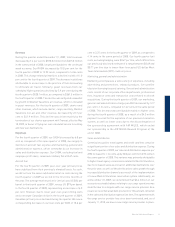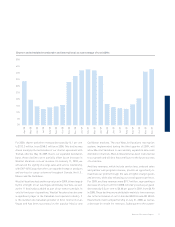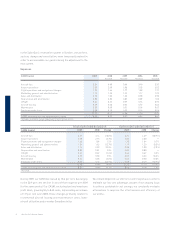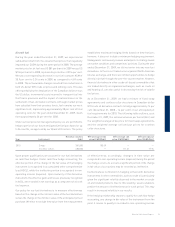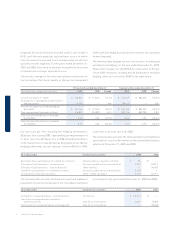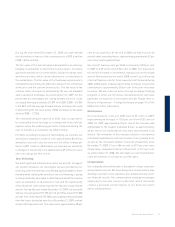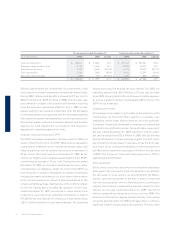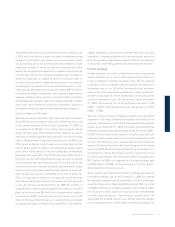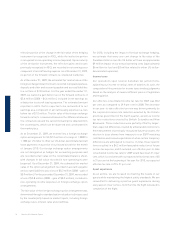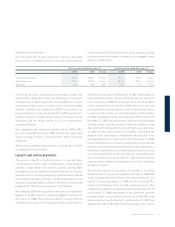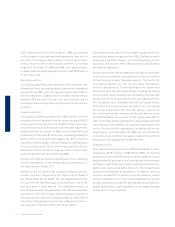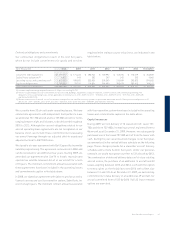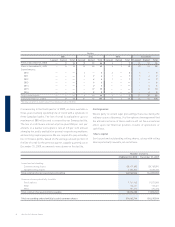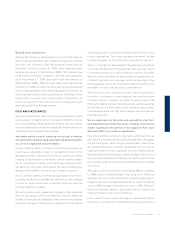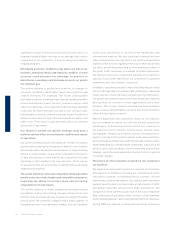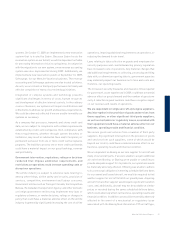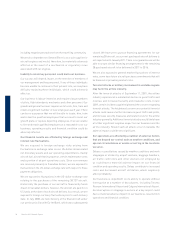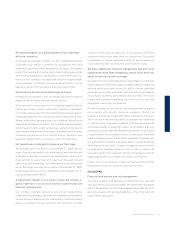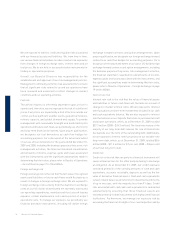Westjet 2009 Annual Report Download - page 50
Download and view the complete annual report
Please find page 50 of the 2009 Westjet annual report below. You can navigate through the pages in the report by either clicking on the pages listed below, or by using the keyword search tool below to find specific information within the annual report.
20 WestJet 2009 Annual Report
For 2010, including the impact of foreign exchange hedging,
we estimate that every one-cent change in the value of the
Canadian dollar versus the US dollar will have an approximate
$9 million impact on our annual operating costs (approximately
$6 million for fuel and $3 million related to other US-dollar-
denominated expenses).
Income taxes
Our operations span several Canadian tax jurisdictions,
subjecting our income to various rates of taxation. As such, the
computation of the provision for income taxes involves judgments
based on the analysis of several different pieces of legislation
and regulation.
Our effective consolidated income tax rate for 2009 was 28.2
per cent, as compared to 29.9 per cent in 2008. The decrease
in our year-to-date effective tax rate was driven primarily by
the corporate income rate reduction enacted by the Ontario
provincial government in the fourth quarter, as well as income
tax rate reductions enacted by British Columbia and New
Brunswick. These reductions were partially offset by larger-
than-expected differences created by unfavourable revisions to
the measurement of previously-recognized future tax assets, the
election to issue shares from treasury for our ESPP matching
contribution and revised expectations of when certain temporary
differences are anticipated to reverse. In total, these specifi c
items resulted in a $4.2 million favourable reduction of future
income tax expense, and if excluded, our effective year-to-date
consolidated income tax rate for 2009 would have been 31.3 per
cent, which is consistent with our expected effective tax rate of 30
to 31 per cent at the beginning of the year. For 2010, our expected
effective tax rate is 29 to 31 per cent.
Guest experience
As an airline, we are focused on meeting the needs of our
guests while maintaining the highest safety standards. We are
committed to delivering a positive guest experience during
every aspect of our service, from the time the fl ight is booked to
completion of the fl ight.
effective portion of the change in the fair value of the hedging
instrument is recognized in AOCL, while the ineffective portion
is recognized in non-operating income (expense). Upon maturity
of the derivative instrument, the effective gains and losses
previously recognized in AOCL are recorded in net earnings as a
component of aircraft leasing expense. As at December 31, 2009,
no portion of the forward contracts is considered ineffective.
As at December 31, 2009, the estimated fair market value of the
foreign exchange forward contracts recorded in prepaid expenses,
deposits and other and accounts payable and accrued liabilities
is a net loss of $1.0 million. For the year ended December 31,
2009, we realized a gain before tax on the forward contracts of
$5.6 million (2008 – $4.6 million), included in net earnings as
a deduction to aircraft leasing expense. The estimated amount
reported in AOCL that is expected to be reclassified to net
earnings as a component of aircraft leasing expense is a loss
before tax of $1.0 million. The fair value of the foreign exchange
forward contracts is measured based on the difference between
the contracted rate and the current forward price obtained from
the counterparty, which can be observed and corroborated in
the marketplace.
As at December 31, 2009, we entered into a foreign exchange
option arrangement for US $7.3 million at a range of 1.0800 to
1.1500 per US dollar to offset our US-dollar-denominated aircraft
lease payments on a portion of our leased aircraft for the month
of January 2010. Our foreign exchange option arrangements
are not designated as hedges for accounting purposes and
are recorded at fair value on the consolidated balance sheet,
with changes in fair value recorded in non-operating income
(expense). As at December 31, 2009, the estimated fair market
value of the option arrangement recorded in accounts payable
and accrued liabilities was a loss of $0.2 million (2008 – gain of
$0.9 million). For the year ended December 31, 2009, we recorded
a loss of $3.8 million (2008 – gain of $0.9 million), included in
non-operating income (expense) on foreign exchange option
arrangements.
The fair value of the foreign exchange option arrangement was
determined through a standard option valuation technique used
by the counterparty based on market inputs, including foreign
exchange rates, interest rates and volatilities.



